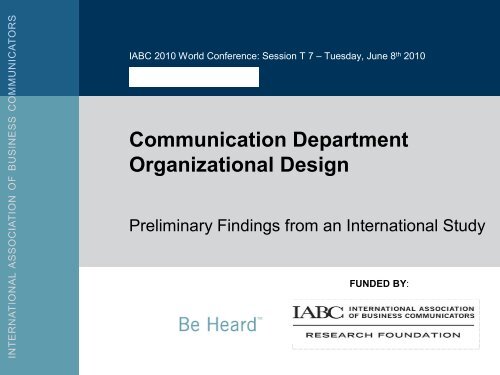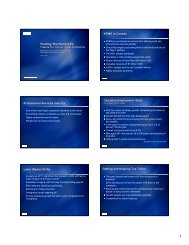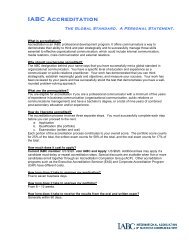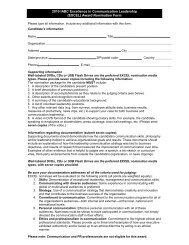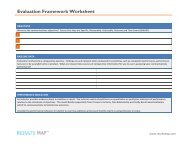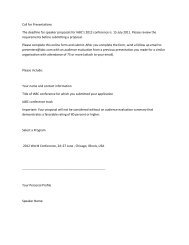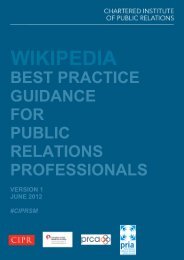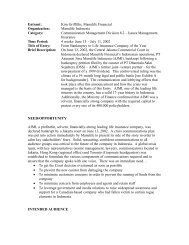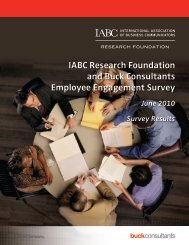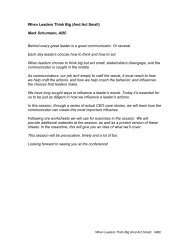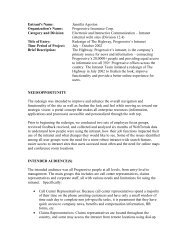Communication Department Organizational Design - International ...
Communication Department Organizational Design - International ...
Communication Department Organizational Design - International ...
Create successful ePaper yourself
Turn your PDF publications into a flip-book with our unique Google optimized e-Paper software.
IABC 2010 World Conference: Session T 7 – Tuesday, June 8 th 2010<br />
Additional Information Text<br />
<strong>Communication</strong> <strong>Department</strong><br />
<strong>Organizational</strong> <strong>Design</strong><br />
Preliminary Findings from an <strong>International</strong> Study<br />
FUNDED BY:<br />
CHAPTER LOGO AREA
• Krishnamurthy Sriramesh Ph.D. / New Zealand is professor of<br />
public relations in the School of Business at Massey University<br />
• Fraser Likely M.A. / Canada is president and managing partner<br />
of Likely <strong>Communication</strong> Strategies Ltd.<br />
• Maria Aparecida Ferrari Ph.D. / Brazil is associate professor of<br />
public relations, advertising and tourism at Methodist University<br />
• Bert Regeer / Netherlands is vice president of communications<br />
planning, operations and CI for Shell <strong>International</strong> B.V.<br />
• Danny Moss Ph.D. / United Kingdom is Bank of America<br />
professor of corporate and public affairs at the University of Chester<br />
2
• To identify the factors that influence<br />
communication department structure.<br />
• To identify the communication department<br />
structural models that seem to work effectively in<br />
light of these factors.<br />
• To identify if there is a link between communication<br />
department structural models and the type of<br />
organization, the size of the organization, an<br />
organization’s culture and/or the organization’s<br />
geographic location.<br />
3
• Literature Review<br />
• Executive Interviews<br />
• Online Survey<br />
ü http://formicweb.chester.ac.uk/webforms/?TAG=IABCinternational<br />
4
• The literature review draws on works from across a<br />
range of disciplinary fields, including:<br />
ü <strong>Organizational</strong> Behaviour<br />
ü <strong>Organizational</strong> Strategy<br />
ü Management<br />
ü <strong>Communication</strong>s and Public Relations<br />
• Very limited attention has been paid to the role of<br />
the communication function in the literature on<br />
organizational structure.<br />
• Much of the thinking about structural design has<br />
taken a static snap shot view rather than examining<br />
structural change over time.<br />
5
<strong>Organizational</strong><br />
Forms<br />
Simple Forms<br />
Unitary<br />
U Forms<br />
Multidivisional<br />
M Forms<br />
Matrix Forms<br />
Marketbased<br />
Network Forms<br />
Virtual/Hollow<br />
Forms<br />
Key<br />
Characteristics<br />
Direct close control of all functional activity by<br />
head; top down control<br />
Functional department organization; centralized,<br />
hierarchical<br />
Small HQ core with strong semi autonomous<br />
divisions along product, brand or geographical<br />
lines (each with own functions); decentralized<br />
Functions and divisions, with dual reporting for<br />
employees; integrated<br />
Centralized core with outsourced functions and/or<br />
divisions<br />
May or may not have physical presence;<br />
collaboration of a number of organizations<br />
6
• The topics of organizational and communication<br />
departmental structure have received very limited<br />
coverage within the academic and practitioner<br />
communication/public relations literatures.<br />
ü<br />
Excellence Study<br />
• Subsequently, there has been little research on the<br />
range of new thinking about organizational<br />
structures and their relation to communication<br />
function structure within the communication/public<br />
relations literature.<br />
7
• Executive Interviews<br />
ü<br />
ü<br />
ü<br />
ü<br />
Over 25 interviews have been completed with<br />
communication department CCOs, from profit and nonprofit<br />
organizations.<br />
CCOs are from organizations that have their headquarters<br />
in various locales around the globe, with all 5 continents<br />
represented.<br />
CCOs are from a diverse group of organizations that work<br />
in a great variety of business and nonprofit sectors.<br />
CCOs were chosen by reference, forming a convenience<br />
sample chosen based on factors such as participant<br />
accessibility, availability and willingness to participate as<br />
well as location.<br />
8
• Interview Question:<br />
Which communication subfunctions report to you?<br />
Directly? Functionally?<br />
9
• Interview Question:<br />
Which communication subfunctions report to you?<br />
Directly? Functionally?<br />
ü For approximately 50% of the organizations studied, all<br />
functions reported directly.<br />
ü In 25% of the cases, communication functions located in<br />
business units, regions and/or internationally reported<br />
functionally.<br />
ü In another 25% of cases, communication functions located<br />
in business units, regions and/or internationally did not<br />
report directly or functionally, but were independent.<br />
10
• Interview Question:<br />
To whom do you report? Where does that person<br />
rank in the organizational hierarchy?<br />
11
• Interview Question:<br />
To whom do you report? Where does that person<br />
rank in the organizational hierarchy?<br />
ü Approximately 70% report right at the top<br />
ü 25% report to an executive who reports to the top person<br />
ü 5% report to a manager who reports to an executive who<br />
reports to the top person<br />
12
• Interview Question:<br />
How does the organizational structure for the<br />
communication department relate to the<br />
organizational structure for the organization itself?<br />
13
• Interview Question:<br />
How does the organizational structure for the<br />
communication department relate to the<br />
organizational structure for the organization itself?<br />
ü Parallels the structure more or less exactly: 65%<br />
ü Entirely different structure: 30%<br />
ü Hybrid, some parallels some different aspects: 5%<br />
14
• Interview Question:<br />
What factors do you think have the greatest<br />
influence on the communication function and<br />
structure in your organization?<br />
15
• Interview Question:<br />
What factors do you think have the greatest<br />
influence on the communication function and<br />
structure in your organization?<br />
ü CEO/executive team influence: 45%<br />
ü External environmental factors: 23%<br />
ü Type of business/strategy of business we are in: 13%<br />
ü Organization’s financial situation: 10%<br />
ü Staff capabilities/competencies: 9%<br />
16
• Interview Question:<br />
What was the rationale for your current<br />
communication structure?<br />
17
• Interview Question:<br />
What was the rationale for your current<br />
communication structure?<br />
ü Changes brought on relatively soon when new CCO hired<br />
ü Changes enacted by CCO over time<br />
ü Upsizing/downsizing changes in the organization<br />
ü CEO direction<br />
ü To have <strong>Communication</strong> more closely mirror organization &<br />
its business<br />
ü Reaction to external environmental factors<br />
18
• Interview Question:<br />
How much of the communications work do you do<br />
inhouse and how much of it is done by consultants,<br />
if at all?<br />
19
• Interview Question:<br />
How much of the communications work do you do<br />
inhouse and how much of it is done by consultants,<br />
if at all?<br />
<strong>Communication</strong> work performed inhouse:<br />
ü 90% + inhouse<br />
ü 80 90% 15%<br />
ü 70 80% 5%<br />
ü 60 70% 15%<br />
ü 50 60% 15%<br />
ü Less than 50% 20%<br />
30% of respondents<br />
20
• Interview Question:<br />
In what way does the structure of the department<br />
help to make the PR/C department a high performing<br />
one?<br />
21
• Interview Question:<br />
In what way does the structure of the department<br />
help to make the PR/C department a high performing<br />
one?<br />
ü Its flexibility, allowing communication support at all levels:<br />
corporate; business line; and region.<br />
ü It enables good communication and information exchange<br />
across the whole communication function.<br />
ü It supports good and/or standardized management and<br />
professional practices across the function.<br />
ü It overcomes the barriers of an organizational structure that<br />
is in silos, thus fostering organizational integration.<br />
22
• Interview Question:<br />
What are the major trends relating to communication<br />
department structure?<br />
23
• Interview Question:<br />
What are the major trends relating to communication<br />
department structure?<br />
ü Structures that support staffing flexibility to move people<br />
between units and teams<br />
ü Structures that support communication as one integrated<br />
function, with clear direct and functional reporting lines<br />
that cross the organizational structure<br />
ü Structures that support flexibility in staffing, to add and<br />
subtract human resources as the need arises.<br />
24
• URL:<br />
http://formicweb.chester.ac.uk/webforms/?TAG=IABCinternational<br />
Thank you!<br />
25


